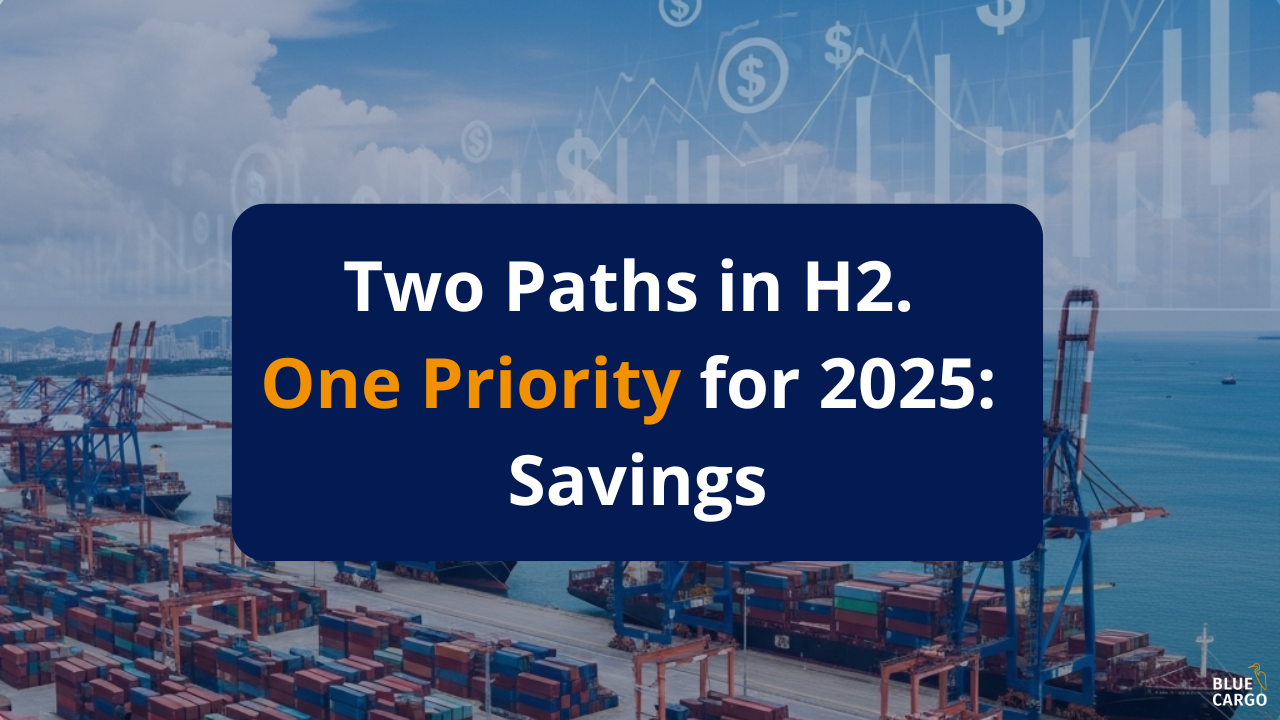
By BlueCargo | July 2025
The midyear S&P Global Journal of Commerce container shipping outlook has made one thing clear: as H2 2025 unfolds, beneficial cargo owners (BCOs) are facing a layered mix of uncertainty: economic drag, capacity unpredictability, and tariff anxiety.
However, amid all these shifting tides, a deeper theme is emerging: cost discipline and operational savings are now the clearest levers of control.
Here’s what matters most for importers and exporters, and how forward-thinking teams are shifting strategy.
Tariffs May Dominate the Headlines, But They’re Not the Only Problem
Yes, tariff strategy is top of mind for global shippers.
With the effective rate hovering around 10%, many companies are still speculating rather than acting. Most are holding off on large-scale changes, betting that new legislation or trade agreements will hold the line.
But this wait-and-see posture could backfire. As the report highlights, tariffs are inflationary with a delayed impact, making Fed interest rate cuts harder to justify. This environment puts added pressure on carrying costs, especially as we head into Q4’s inventory-heavy holiday cycle.
Diversification Decisions Need Real-Time Freight Costs Intelligence
China diversification continues to be a complex, ongoing shift. Some BCOs are accelerating sourcing changes; others are hesitant due to cost structures or internal inertia.
However, with front-loading behaviors resurging and the potential for spot surges tied to the reintroduction of niche carriers (especially on the West Coast), having static supplier models could result in costly mismatches between demand and freight flow.
The smart move? Build in real-time visibility to adapt freight routing and mode allocation as capacity fluctuates, especially as blank sailings return and spot rate spikes threaten allocations.
MQCs, Loyalty, and Capacity Access: The New "Freight Tradeoff"
BCOs are now grappling with a familiar yet intensified dilemma: commit to Minimum Quantity Commitments (MQCs) to secure capacity assurance, or remain flexible to pursue favorable spot rates.
This race between short-term savings and long-term loyalty is creating a fractured contract landscape.
But even a favorable rate won’t guarantee space. As the report warns, blank sailings are already impacting actual availability, putting BCOs at risk of having a rate but no ride.
Those without a clear reconciliation process between contracted volume, actual liftings, and carrier performance risk losing both leverage and clarity.
What’s Missing in the Conversation? Organizational Discipline
More than rate negotiations or trade policy reactions, the overlooked advantage lies in internal alignment.
BCOs must foster tighter coordination between finance, procurement, sourcing, and inventory teams. This is foundational.
Teams need shared visibility into:
- True landed cost per SKU
- Fees tied to TEU tonnage, surcharges, and port turn times
- Trade-offs between rate and reliability
Only with synchronized systems and disciplined internal communication can organizations act decisively when disruptions arise.
EU-US Trade, Red Sea Disruptions, and the Currency Factor
While tariffs dominate US-China conversations, transatlantic trade concerns are different.
For many BCOs, the biggest issue isn’t the duty, but rather the euro-dollar exchange rate. Spot rates remain relatively stable, and demand is holding steady, but currency volatility could erode margins quickly if not closely monitored.
Meanwhile, the rerouting of the Red Sea and vessel retirements are shifting GEP capacity in unexpected ways. Carriers are maintaining a flat TEU supply through a combination of vessel phaseouts and strategic redeployments.
This makes freight forecasting and fee validation more critical than ever.
Action Items: A Mid Year "To-Do" List
The second half of 2025 doesn’t offer a single playbook, but it does offer some clear principles:
- Look beyond macro headlines. GDP growth, interest rates, and tariffs are important, but operational savings are where your organization can make the biggest impact right now.
- Audit every freight invoice. Surges in blank sailings and variable surcharges demand airtight validation. Automated audit processes are a necessity.
- Strengthen cross-functional coordination. Eliminate silos between logistics, finance, and sourcing to enable proactive decision-making.
- Monitor HS code exposure. Regulatory changes and tariff shifts can create unnecessary costs. Early identification can drive reclassification savings.
- Build freight elasticity models. Different commodities and verticals are experiencing very different consumer responses. Use internal and market data to adjust your forecasts with precision.
Conclusion: Margin Protection
Shippers have been reactive for too long in H1. However, the second half of 2025 serves as a reminder that true resilience doesn’t come from guessing the next spot rate or waiting for Washington. It comes from clarity, control, and discipline.
While no one can predict the next blank sailing or tariff revision, shippers can (and must) invest in systems that give them visibility, accountability, and a reliable path to savings.
Because in this environment, margin protection consistently outperforms rate prediction.
----
Other useful resources HERE.


